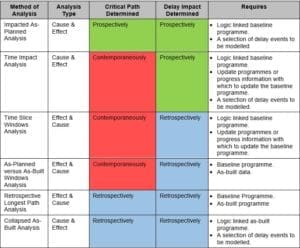A ray of light cast over the ‘dark art’: Considerations regarding delay analysis arising from Thomas Barnes & Sons plc v Blackburn with Darwen Borough Council
November 2022On 17 October 2022, the High Court handed down its decision in Thomas Barnes & Sons plc v Blackburn with Darwen Borough Council [2022] EWHC 2598 (TCC), which related to the construction of a bus station in Blackburn.
The claimant, Thomas Barnes & Sons plc (in administration) (‘Thomas Barnes’) was the contractor employed by a local Council, with the project suffering significant costs increases and delay. The Council purported to terminate Thomas Barnes’ contract and engage another contractor to complete the works. Soon after, Thomas Barnes went into administration, with the administrators subsequently seeking approximately £1.7 million in damages. This included an entitlement to prolongation and delay-related damages, which led the Judge to provide some discussion on the differing forms of expert delay analysis relied on by the parties.
Society of Construction Law Delay and Disruption Protocol
The Society of Construction Law Delay and Disruption Protocol (‘SCL Protocol’) sets out the following differing methods of delay analysis that can be used to analyse the impact of a delay event to the critical path of a construction programme:

In Thomas Barnes, the Judge noted that it would be wrong to place too much importance as to whether a particular method of delay analysis had been strictly followed, stating that:
‘The SCL Protocol itself discourages such an approach. It states in the introduction that: (a) its object is to provide useful guidance; (b) it is not intended to be a contract document nor to be a statement of the law; (c) its aim is to be consistent with good practice rather than to be a benchmark of best practice; and (d) its recommendations should be applied with common sense. It states under paragraph 11.2 that “irrespective of which method of delay analysis is deployed, there is an overriding objective of ensuring that the conclusions derived from that analysis are sound from a common sense perspective”.
Thus, it would be wrong to proceed on the basis that, because the SCL Protocol identifies six commonly used methods of delay analysis, an expert is only allowed to choose one such method and any deviation from that stated approach renders their opinion fundamentally unreliable. It must be borne in mind that the common objective of each is to enable the assessment of the impact of any delay to practical completion caused by particular items on the critical path to completion. However, I do accept that if an expert selects a method which is manifestly inappropriate for the particular case, or deviates materially from the method which he has said he is following, without providing any, or any proper, explanation, that can be a material consideration in deciding how much weight to place on the opinions expressed by the expert.’
The SCL Protocol in practice
Therefore, the SCL Protocol itself states that it is not to be considered the black letter law of delay analysis but more a guide for the appropriate delay method to be used. The appropriate delay should be determined in accordance with the terms of the relevant contract. For example, under clause 2.24 of the unamended JCT Design and Build Contract 2016, where it is apparent that the progress of the works:
‘…is being or is likely to be delayed the Contractor shall forthwith give notice to the Employer of the material circumstances, including the cause or causes of the delay, and shall identify in the notice any event which in his opinion is a Relevant Event.’
Further, the notice is required to give particulars of the expected effects, including an estimate of any expected delay in the completion of the Works. The provision of this notice is a precondition to being granted an extension of time, with the ‘particulars’ referred to normally taking the form of an updated construction program identifying the impact of the ‘Relevant Event’ on the critical path of the project.
As the wording of the above clause is ‘being or likely’ to be delayed, this would imply that a contemporaneous (‘being’ or ‘current’) or prospective (‘likely’ or ‘future’) delay analysis method should be used to determine the impact of the event on the critical path. However, where the wording of the relevant clause is differently drafted to the effect that a delay notice should be submitted when the Works ‘have actually been delayed’, then this would imply that a retrospective delay analysis should be used.
Especially when part of the claim centres around an extension of time, expert delay analysis is commonly relied on in both adjudication or litigation to prove or disprove a claim. In light of the Judge’s comments in Thomas Barnes, it is not a requirement for a particular method to be strictly followed. However, delay experts should be conscious of the impact that a deviation from the stated method used or the use of an inappropriate method will have on the weight of their evidence without a reasonable explanation.
Other observations from Thomas Barnes
1. The decision also provides a good overview of the principles surrounding repudiation and termination. Although the Judge found that the Council had failed to validly terminate under the contract due to invalidly serving a termination notice, this was found not to be critical as the Council had properly accepted the Contractor’s repudiatory breach for failing to proceed regularly and diligently with the works.
2. Traditional approaches to the main cause of delay have been the ‘dominant cause’ approach, focussing on the main cause of the delay, or alternatively, the ‘first in time’ approach, focussing on the event that occurs first. However, the Judge found that concurrent delays had occurred, even though there appeared to be a dominant delay, separate to one that occurred first. In this instance, the Judge made a finding that ‘depending upon the precise wording of the contract a contractor is probably entitled to an extension of time if the event relied upon was an effective cause of delay even if there was another concurrent cause of the same delay in respect of which the contractor was contractually responsible’. However, the Judge noted that despite being entitled to an extension of time for a dominant cause delay, the Contractor would not be entitled to costs for loss and expense where a separate concurrent delay occurred for which the contractor was contractually responsible.
3. The decision was also particularly damning of the Contractor’s evidence in light of the new Civil Procedure Rules Practice Direction 57AC. It was noted that witness statements relied on were ‘replete with commentary and opinion notwithstanding that each had signed confirmations of compliance which included the required statement that they understood that the purpose of their witness statement was to set out matters of fact of which they had personal knowledge and not to argue the case, either generally or on particular points’. Therefore, the Judge stated that a witness could not complain if a court took these actions into account when assessing their credibility.
For further reading, a copy of the decision can be found here.
Download PDF








